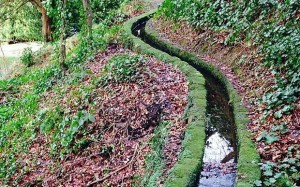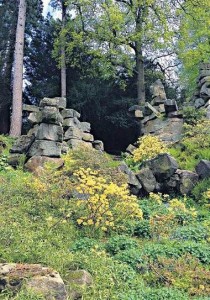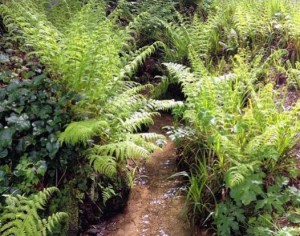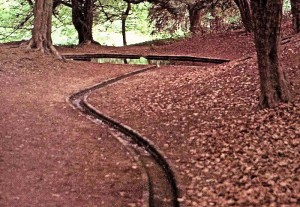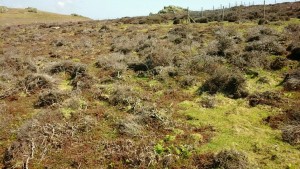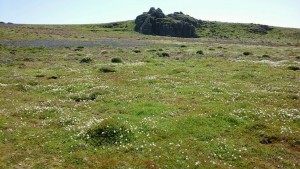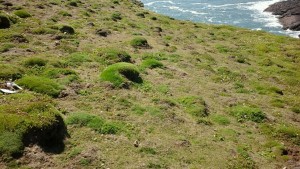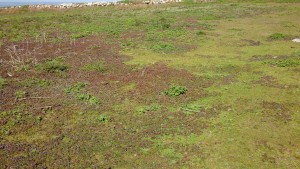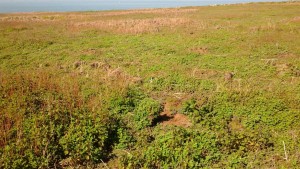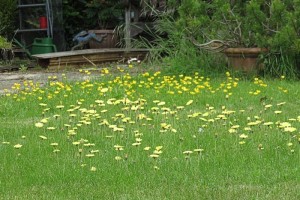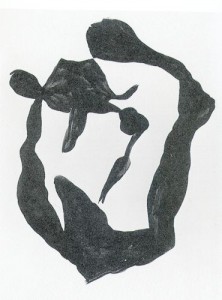1 Chatsworth at Chelsea
The winner of the 2015 coveted Chelsea Flower Show double prize of ‘gold’ and ‘best of show’ was Dan Pearson with his installation entitled, ‘Chatsworth Garden’. Pearson’s exhibit was inspired by the landscape art of Joseph Paxton the great Victorian engineer and architect of the Crystal Palace. In particular, Paxton created two small additions to the landscape garden of the Duke of Devonshire’s Chatsworth estate, namely, The Rockery’ and ‘The Trout Stream’,
The Trout Stream at Chatsworth is a narrow rill that channels water from the moor above into the garden, looping down to a rocky waterfall, from where it feeds the lower formal ponds. On its way it passes through narrow stone channels and tumbles gently through miniature falls. Sometimes the incline is so shallow, the movement so slow, it almost appears to be flowing backwards, and thus has striking reflective qualities (Figs 1 and 2).
Fig 1 The Trout Stream at Chatsworth
To realise the essence of Chatsworth’s stream and rockery at Chelsea , Pearson imported stone from a local Derbyshire quarry to act as a backdrop and planted in such a way as to emulate the surroundings at the estate, which he visited many times in the lead-up to designing the garden.
Fig 2 The Rockery at Chatstworth
Most of Pearson’s hard landscaping at Chelsea was naturalistic, but there were some utilitarian interventions: an oak boardwalk and sandstone stepping stones lead through the planted space and an oak sculpture – representing the veteran oaks at Chatsworth – stands at the culmination of the stream (Figs 3 and 4). “I wanted to capture the monumentality and drama of the rockery as a backdrop”, Dan Pearson said.
Fig 3 Chatsworth at Chelsea
Fig 4 Chatsworth at Chelsea: the rockery
Pearson’s interest in the rill as an historical feature of landscape design is evident in his earlier writings about the garden of Rousham in Oxfordshire. This is one of the classic English landscape gardens and he gives a lengthy description of it in the book Spirit. The garden was the work of one of the key figures of the English landscape movement, William Kent, who was asked to refine the garden in 1737 after the framework had been designed by Charles Bridgeman in the 1720s. Many of the eighteenth century features may still be seen (Fig 5).
Fig 5 The Serpentine Rill at Rousham
The cultural legacy of Rousham takes us further back to its origins in the 17th century art of Claude Lorrain. Lorrain was a Frenchman who lived in Rome for most of his life yet his landscapes look distinctly English. Rambling, deciduous trees tumble down to a gently bubbling, rock-fringed lake, flanked by a ruined folly. This similarity, between rural England and rural Greece, as painted by a Frenchman to look like 17th-century Italy, is no coincidence. It was the Picturesque Movement of the mid-18th century that was essentially a part of the ecological culture of land ownership, which invented the idea of what an English landscape should look like. It was Lorrain’s paintings that helped inspire the movement which bolstered the social standing of country landowners.
This ‘Lorrain effect’ is precisely what the 18th‑century landscape architect Charles Bridgeman was aiming for at Rousham. His tour de force is the garden of Stowe. Among the landscape highlights at Stowe, which are scattered through its great parkland, are examples of Greek architecture, a menagerie, Dido’s Cave and temples to Venus, to Ancient and Modern Virtue, to Friendship and to British Worthies. Around this time at Stourhead in Wiltshire, the banker Henry Hoare was so keen on Lorrain that some historians have suggested that the whole 18th century garden is a transcription of Lorrain’s great canvas, ‘Coast View of Delos with Aeneas’.
2 Landscapes and ecosystems
Landscapes and ecosystems are the two major spatial units supporting 21st century environmental research. Landscape ecology and landscape art are the intellectual markers of cultural ecology and were born from similar desires. Their common objective is to accurately describe the richness and beauty we all perceive in the outdoor rural environment. A particular view is analysed in a selective process of discovering shapes, forms, colours and associated knowledge all of which define the scene. We make mental models to express our understanding of the configuration of ideas; the array of lines, the patches of colours and textures, the events that have influenced what we see as detail, and the overall evenness or fragmentation of what we see as a whole. Both disciplines love contemplating the contrasts between edges and patches and present them in words, plantings or paintings. They remind us that science says we are part of nature in everything we do whether it is begetting a child or planting a tree..
Parallels of gardening and painting go much further. Henri Matisse, Gustav Klimt, and Paul Klee experimented tirelessly with nature-inspired configurations of patches of colour, different sized patches, the shape of each patch, the orientation of “floating” patches with the straight edges of the canvas and with other patches inside the artwork’s boundaries. Landscape ecologists similarly ponder patches such as ponds hedgerows and clumps of trees embedded in regularly textured farmlands. The “right” configuration can bring harmony to either model. To conservation biologists, for instance, the size and shape of a patch of trees may mean the difference between protection of a rare species and its local extinction. Informed intuition serves both painters and ecologists well.
Landscapes have been conceptualised in European art since the Greeks first began reproducing images of the places described in mythic literature. In these early works, features of the landscape were not represented in relation to the viewpoint of the observer or a precise visual experience, but were instead based on meanings found in legendary environmental narratives. They expressed ideas more than any actual places and there was no one better than Lorrain who achieved this end..
Artists did not begin depicting landscapes in their own right, separate from the narrative context that gave them literary meaning, until the fourteenth century, when teachers started instructing their students to paint the landscape as it appears in reality, not memory. Now, landscapes are the starting point for both art and science. With no place on Earth remaining untouched by human settlement they are cultural artifacts. They are the visible, spatial functional matrix and living space for all organisms, including humans and their populations and the source of their natural resources. This complexity is multidimensional and multifunctional, dealing with the dynamic relationships between culture, ecology and the cognitive mental and perceptual dimensions of the outdoors transmitted by cultural information. The latter is used to build notional layers of understanding, which give landscapes a central position in defining an individual’s cultural place in nature, be it national or parochial.
3 Ecotopes: the fundamental scenic units
Landscape was first defined geographically by Alexander Von Humboldt, born 1769, as a visual entity that expresses “all the characteristics of a land”. It is a spatial entity, having a variable extent and scale, with territorial properties that may be perceived and experienced. This definition was further developed in the European Landscape Convention to emphasise the dynamic nature of landscape as an area “perceived by people, whose character is the result of the action and interaction of natural and/or human factors”. Therefore, a functional definition of landscape is “a heterogeneous land area composed of a cluster of interacting ecosystems that is repeated in similar form throughout”. This highlights the interactions between spatial pattern and ecological process, which are both studied as the causes and consequences of spatial heterogeneity of the outdoors across a range of scales. Thus, we can define spatial patterns as ecological land units, or ecotopes as they have been defined.
Ecotopes are generally regarded as the smallest functional landscape units that can be painted, photographed or measured. They are sometimes addressed as ‘landscape cells’. Ecotopes are best defined as homogeneous ecological units, their spatial expression being predominantly determined by their structural characteristics and arrangement in space. They are the fundamental visual units of art and science. Scientifically they are characterized by their species composition and the flows of energy, matter and information between organisms and the non-living elements of the cell. The organized complexity of landscape is based on this complexity of material processes governing the flow of energy/matter and biophysical information within and between ecotopes. Thus, a landscape is composed of many very different elements and components that interact and are structured within a spatial organization that is invariably subject to human natural resource management. In other words, ecotopes are the closely interwoven natural and cultural entities comprising the building blocks of the human ecological niche. Change is an inherent property of ecotopes as they develop or regress.
In the following section, these ideas connecting art and ecology as a unified cultural framework are explored using digital imaging to unravel the relationships between ecotopes and landscapes.
4 Islands in the mind
Skomer is a small Welsh offshore island and a national nature reserve. It has a distinctive landscape of parallel rocky ridges, separated by troughs of maritime scrub held in check by an indigenous population of rabbits. To place Skomer in a wider perspective, it is at the micro-landscape level of rabbit grazing and the nesting burrows of seabirds that the problem of pattern and scale actually models the central problem in ecology, unifying population biology, ecosystems science and marrying basic and applied ecology. In this tightknit scheme of things, the issue of ecological pattern is inseparable from the problem of the generation and maintenance of biodiversity. Not only is the heterogeneity of the environment often essential to the coexistence of species, but the very description of the spatial and temporal distributions of species is really a description of patterns of diversity. Thus, an understanding of botanical pattern in the landscape, its causes and its consequences, is central to understanding principles of evolution, such as speciation, as well as ecological processes governing succession, community development, and the spread and persistence of individual species. These processes are governed by past and present cultures through the value they place on natural resources.
On Skomer, it is the feeding and social behaviour of rabbits that produces a resilient, high topographical diversity in the low biodiversity in the microcosm of maritime scrub of the island’s central fields and cliff tops. Rabbits thus hold the key to the existence of a range of mechanisms for generating pattern in landscapes further afield on greater scales. The resultant visual diversity is celebrated in a digital gallery of snapshots taken at various points around the island on 15th May, 2015. The gallery highlights a new aspect of the art of micro-landscapes, which expresses the fortuitous aesthetics arising through the dynamics of botanical microcosms.
http://tamron.myphotoexhibits.com/exhibits/13197-edges-and-patches
The basic principle of vegetation dynamics on Skomer is that rabbit grazing severely restricts the growth of species that are palatable as seedlings or mature plants. Their burrowing and scraping produces a seed bed for colonisation by unpalatable species, which grow as clumped monocultures shaped by their constant nibbling. These visually dominant clumps eventually die and are colonised all over again. The time scale of this cycle is measured in decades but we know little about the factors governing lifespans of the botanical players. At the moment the sequence of species cannot be predicted but over the past forty years it has involved the rise and decline of sorrels and docks, scentless mayweed, Yorkshire Fog, woodsage, ground ivy, sea campion, heather, red campion and bluebells. All these species exist interspersed in mainland coastal scrub, which in the absence of rabbits would surely dominate the landscape of Skomer. For example, this assembly of gorse/ bramble/ blackthorn/ bracken is currently the visually dominant feature of Marloes Deer Park, the nearest point on the mainland. There, with a very low rabbit population, scrub is managed by burning and grazed by beef cattle. It is also found at other places along the coastal slopes of West Wales, where it is sometimes grazed by sheep. The position of trees in this maritime habitat can be imagined from the ancient woodland of Pinderi Cliffs Nature Reserve, which clings to the precipitous slopes above the sea north of Llanrhystud, about fifty miles from Skomer. The principal biological interest of this site is a steeply west-facing sessile oak woodland, which includes an interesting assemblage of other species such as blackthorn, hawthorn, hazel, small-leaved lime, spindle, rowan, and wych elm.
Regarding the current tree-free landscape of Skomer, the following images are snapshots of ecotopes illustrating the various stages of ‘rabbit-driven’ processes that were evidend on Skomer, 13th May, 2015 (Figs 6-10).
Fig 6 Degraded maritime heath; north facing coastal slope.
Fig 7 Above Bull Hole; clumps of dead thrift colonised by sea campion with a pool of bluebells.
Fig 8 Pigstone Bay; Clumps of nibbled thrift
Fig 9 Central grassland: Field 1; patch of ground ivy with rabbit lawns.
What has all this to do with Dan Pearson and his Chelsea Gold medal?
In terms of gardens being personal expressions of cultural ecology, they are ecological islands composed of ecotopes managed for their visual attractiveness. Gardens also consist of islands within islands.
Fig 10 Field 1: Large rabbit warren with woodsage and moss.
In most gardens, a ubiquitous island is the lawn. t
In most gardens, a ubiquitous island is the lawn. The family lawn may be regarded as the most labour intensive expression of urban culture aimed at creating satisfying biological surroundings. Although the vision of a household lawn may be a monoculture of short velvety grass, the reality is that most domestic lawns consist of collections of ecotopes defined by the local dominance of ‘weeds’. They are in fact part of an ecological set of grassy habitats, which on Skomer are produced by rabbit grazing whereas in the garden these herbivores are replaced by the lawn mower.
Satellite photographs in the United States have shown that lawns (residential and commercial sites, golf courses, etc.) occupy 45.6 million acres, or 23% of urbanized land. At ground level the major ecological effect of a lawn mower is to encourage the spread of plants, such as grasses, which reproduce by growing roots from specialised prostrate stems (stolons). These grow out from the centre, hugging the ground, because stems that grow in this way survive the machine’s rotating blades. In this respect, grasses are in competition with broad-leaved, low growing plants which reproduce and spread in the same way. These are the weeds of lawns, which may be so vigorous relative to the grasses that over time they become the dominant life forms. It is at this point that the gardener resorts to selective weedkillers to meet the objective of a lawn that is a hundred percent grass. An alternative response is to encourage the weedy plants, reducing the chemical inputs, to create a combined stoloniferous habitat where the ecotopes consist of a high proportion of clover, buttercups, daisies or hawkweeds in a grass matrix. In fact these ecotopes have their own aesthetics. like the windows into vegetation cycling on Skomer. They add colour and may be maintained by a management programme that consists of mowing and uprooting plants that grow in the ’wrong place’ (Fig 11).
Fig 11 Ecotopes of creeping buttercup (upper cluster) and mouse-ear hawkweed (lower cluster) in an urban lawn.
Therefore, by making a stoloniferous mixed lawn the gardener is also experimenting with a managed ecosystem which can have aesthetic outcomes. Also, it is aligned with Dan Pearson’s adoption of the Chatsworth semi-wild ornamental ecotopes for his show garden. A difference in principle is that a lawn island managed for its accidental ecotopes is more sustainable with low inputs of energy and materials although in this respect it is not a free running ecosystem as is the unmanaged Skomer landscape.
5 References
Journal of Landscape Ecology (2010), Vol: 3 ECOSYSTEM AND LANDSCAPES – A CRITICAL COMPARATIVE APPRAISAL Zev Naveh
http://fineartamerica.com/featured/ecosystems-david-herbert.html
http://northcentralart.com/art-painting-ecosystem/
http://www.bbc.co.uk/arts/yourpaintings/paintings/meadows-53912
http://www.deborahsilk.com/art/curric/other/eco/eco_collage.html
http://www.sciencedirect.com/science/article/pii/S0167880997000169
